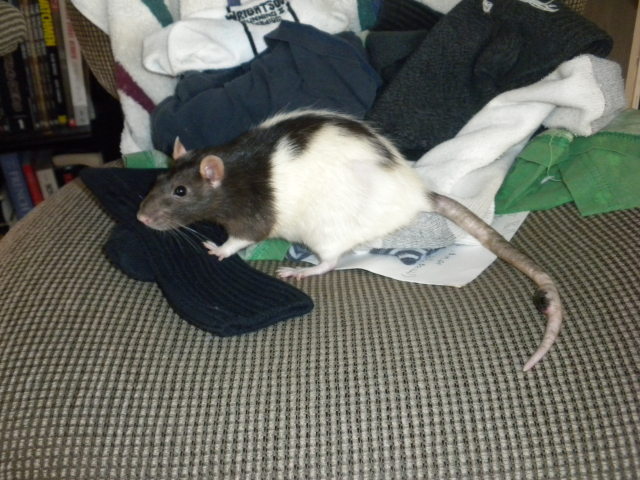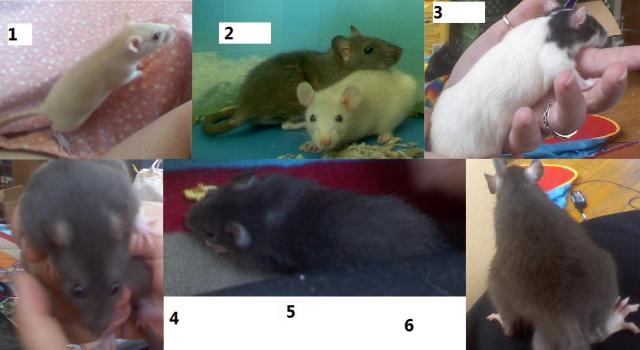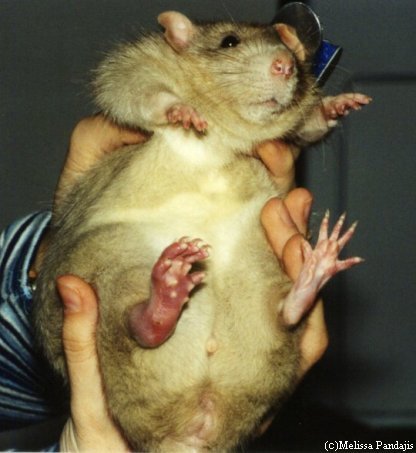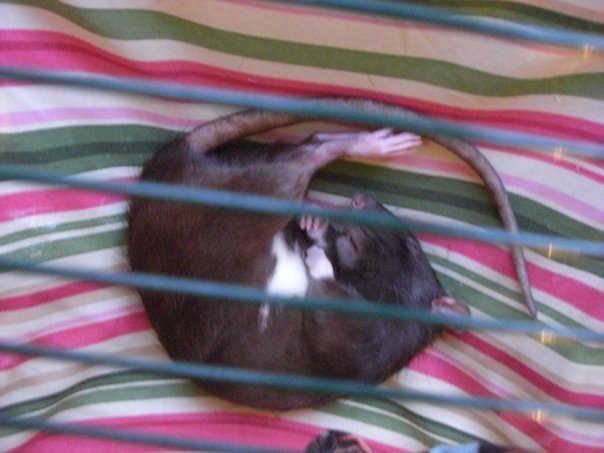QuestionHi Sandra,
I have two female ratties, one about a year and a half (I'm only guessing as they both came from a pet store) the other about 7 months. I was wondering if I could use paper towels instead of litter on the bottom of their cage. I'd love to get the carefresh stuff, but it's so much money. If paper towels would work just as well, I'd prefer those. I also wanted to know if neutering/spaying a rate makes them healthier as it does in a cat or a dog? Also, how much money does this usually cost?
Thank you!
Alex
AnswerI dont care for carefresh to be honest. I like paper towels for them to tear up and nest with but not for litter. The key to good health is proper husbandry and keeping the amount of ammonia down in their cage is the first start. What you can do is this: Line the cage with newspaper, lining each shelf with a decent thickness, say, three layers perhaps? You can go to walmart and purchase a pack of needlepoint canvas, which is cheap at around $1.87 for a pack which has about 6 sheets in it. Depending on the size of your cage, I would buy a few packs so when you have to change them you have enough clean ones too. I lay them over the newspaper. The holes in the plastic needle point canvas will allow urine to flow through and the paper absorbs it.
Next up, the litter pan. Forget spreading litter/bedding all over the floor of the cage. You can put it in a litter box. If the cage is big (I Have a ferret nation) you can use a small cat litter box, but if your cage floor is not really huge, even a shoe box is ok. Plastic is better but you can use cardboard, it just may not last long if your rats love to gnaw on it. Add ASPEN litter. It is cheap and it is safe to use on rats. I used to use it before I trained my rats when they were younger pups. You can simply lift out the litter box and dump it when it gets too dirty. You can change out the urine soaked newspapers as needed, usually daily for rats that urinate alot and if your rats urinate in the litter box and only pee just here and there on the papers, you can change out the papers every other day. The key is to keep it CLEAN and to keep it urine free. A build up of urine creates an odor of ammonia that is not good for the rats at all. How large is your cage?
If you dont want to follow my idea (this is how I have done my cages for years, its just my advice, not a mandatory thing of course....lol) you can always simply buy aspen rather than carefresh. I also buy yesterdays news but I find it in the cat litter section at the grocery store. It is sold for under $7 for this GIANT bag of litter, green bag, but if you go to the pet store, its crazy expensive and costs well over $10 if you buy it for ferrets or rabbits. Its ALL THE SAME, which makes me mad and makes me feel like they are misleading the consumer...but thats another story for another day. :P
Now....about neutering and spaying. lets start with the easy one first. Neutering males: It does absolutely NOTHING for them as far as their life span goes. It does, however, keep them more mild mannered as they age. Now dont get me wrong, males are laid back but around 8 months of age, their hormone levels go bonkers and some sweet males get a bit testy, wanting to be boss with the other rats etc....it quickly passes but there are some nasty fights involved. This is not always the case, but it happens. I have only had two male mischiefs (for those that do not know what a rat mischief is, it is simply another way to say RAT GROUP or RAT COLONY)
Anyhow, only a few of my males have gotten a bit overly zealous and wanted to fight for the role of alpha status....but it didnt occur often. Ironically, I bought four boys from a breeder once and two of them were so aggressive at just five months old, I had them fixed the second day they were home. One of them even had two small tumors that the breeder swore were just "scar tissue" from two old abscesses. She forgot she was dealing with someone that has studied rats for a long time. Scar tissue my abscess. <--- take out the letters B, C, E and one of the letters S and thats what I wanted to say. DWEEE! LOL!!)
Neutering males will keep their fur nice and soft and sometimes, repeat SOMETIMES, stunt their growth. Not always, mind you...but the chance that you have a 2 pound neuter if you neuter him under the age of 6 months is higher than if you do it after puberty, which is between 7 and 9 months of age. Of course without testicles there is no need to worry about testicular tumors, abscesses or anything like that at all. Its not common, though, but it can occur in males that remain intact. Also a good thing about neutering is if they end up alone you can always put the neutered male with females and they introduce well. Even a neutered male is easy to intro to a younger male rat etc....
Now about spaying females?
The only way I will own female rats is to spay them around 4 months of age, but before 5 months of age. Spaying your female rat will help prevent the growth and development of mammary tumors that are a result of high hormone levels that are related to the end of the rats estrus cycle. This is more commonly seen between 18 and 24 months of age give or take a few months.
Pituitary tumors are also an issue. They are also fueled by hormones and start to grow early on in the rats life. However they are not seen usually until the tumor becomes large and it starts to press on the brain. This occurs when the tumor is about the size of a large pea or a tiny grape. I have seen them bigger than a grape to the point they cause an indentation in the brain itself. Spaying females will help prevent the growth of these nasty and always fatal tumors but of course nothing is an absolute guarantee.
Spaying at an early age will help prevent the growth of the COMMON benign mammary tumor sometimes up to 80%. Some vets will say more like 60% but studies done show that, when the female is spayed younger than 6 months with the ideal being between 3 and 5 months of age have a much better chance of remaining tumor free than rats spayed at an older age. This is esp true with pituitary tumors since they tend to develop earlier but again, they dont show signs till they are larger which means the rat is usually over 18 months of age, which gives the impression that PTs are related to the elderly, which is NOT true.
Males are also not in the clear when it comes to mammary tumors since they also have mammary tissue, minus the nipples. However, the good news is that they do not seem to grow back like they tend to do in females and often the male will only get one in his life and no more. Males are also capable of developing pituitary tumors but again, its seen more in females than males.
You can read more about tumors by going to my website, Sandyscrittercity.com

 small red bubble on face
QuestionQUESTION: hi my rat has a small red bubble like
small red bubble on face
QuestionQUESTION: hi my rat has a small red bubble like
 Large lump on tail
Question
Lump on Swiffers Tail
My rat Swiffer has a lum
Large lump on tail
Question
Lump on Swiffers Tail
My rat Swiffer has a lum
 Rattie Colors
Question4 new babies
QUESTION: Hi, I was wonderi
Rattie Colors
Question4 new babies
QUESTION: Hi, I was wonderi
 swollen foot
QuestionQUESTION: Hi Sandra.... I think you have helped
swollen foot
QuestionQUESTION: Hi Sandra.... I think you have helped
 Pet Rat Dying with Tumor
QuestionQUESTION: Dear Sandra,
Again, Dewey, my belove
Pet Rat Dying with Tumor
QuestionQUESTION: Dear Sandra,
Again, Dewey, my belove